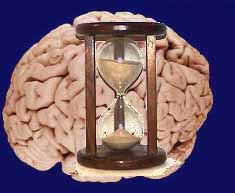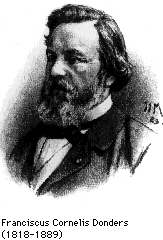Remote Ready Biology Learning Activities has 50 remote-ready activities, which work for either your classroom or remote teaching.
Serendip is an independent site partnering with faculty at multiple colleges and universities around the world. Happy exploring!
TIME TO THINK? |
 |
 |
"The Brain - is wider than the Sky - For - put them side by side - The one the other will contain With ease - and You - beside-" Emily Dickinson, 1830-1886 |
 In the later part of the nineteenth century, both anatomical and physiological observations had developed to the point where many aspects of behavior were comfortably attributed to the nervous system, but "thinking" continued to be considered by many as something different, something non-material, "mental", or "spiritual". In this context, the finding that thinking "takes time" had a significant impact, suggesting that thinking, like other aspects of behavior/human experience, actually had a material basis, and hence might too be equated with nervous system processing.
In the later part of the nineteenth century, both anatomical and physiological observations had developed to the point where many aspects of behavior were comfortably attributed to the nervous system, but "thinking" continued to be considered by many as something different, something non-material, "mental", or "spiritual". In this context, the finding that thinking "takes time" had a significant impact, suggesting that thinking, like other aspects of behavior/human experience, actually had a material basis, and hence might too be equated with nervous system processing.
The Dutch physiologist, Franciscus Cornelis Donders, was the first person to conceive of a way to measure "thinking time", and did so in studies performed in the middle part of the 1860's. The continuation of these studies became a central part of the program of the German physiologist, Wilhelm Wundt, whose laboratory in Leipzig was a major breeding ground of the new discipline of "physiological psychology". James McKeen Cattell, an American who trained in Leipzig, and who himself published papers using the new technique of "psychometry" (Mind, Volume 11, 1886, pp 220-242), wrote of it "It should also be noticed that psychometrical experiment has brought, perhaps, the strongest testimony we have to the complete parallelism of physical and mental phenomena; there is scarcely any doubt but [p. 46] that our determinations measure at once the rate of change in the brain and of change in consciousness" (Mind, Volume 13, 1888, pp 37-51).
 |
| Hipp Chronoscope An early reaction time instrument from the Barnard College Psychology Department History of Psychology Collection |
Because the times involved are quite short (fractions of a second in general), Donders had to develop new technology to make the observations in which he was interested, and technological developments have played a significant role in the continuing development of reaction time research. The process continues. Prior to the advent of high speed computers and the internet, such research required special equipment and associated technical expertise. Today, however, you can do such research yourself on Serendip.
Clicking on "Making Observations" below will take you to a page where you can use Serendip to measure simple reaction times, as well as reaction times in a number of increasingly complex "thinking" tasks. You can use this page to make measurements on your self. You can also use it to conduct studies of your own to see how times vary with any of a number of characteristics such as time of day, subject age, subject sex, and so forth (a Literature Review on Reaction Time by Robert J. Kosinski of Clemson University is available on line). If you do, we'd like to hear about your studies. Clicking on other links below will take you to additional information about reaction time research, the history of thinking about brain and mind, and related materials.